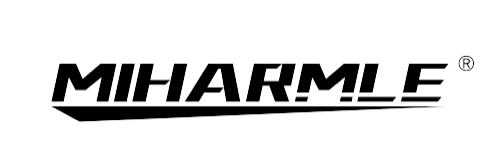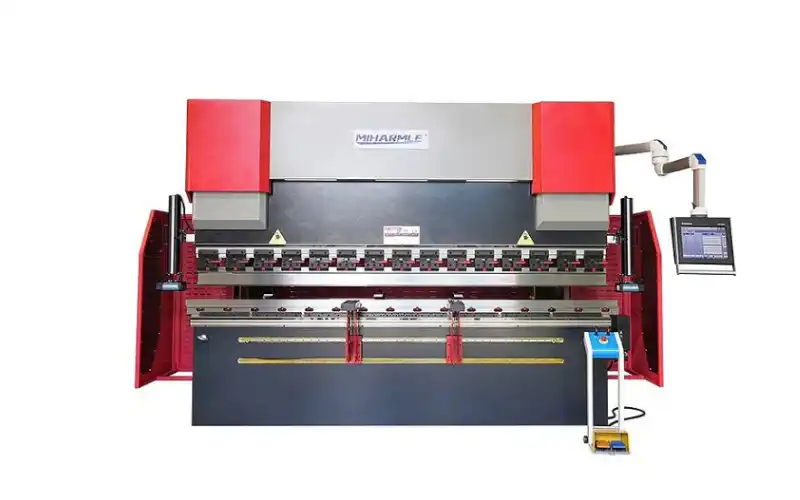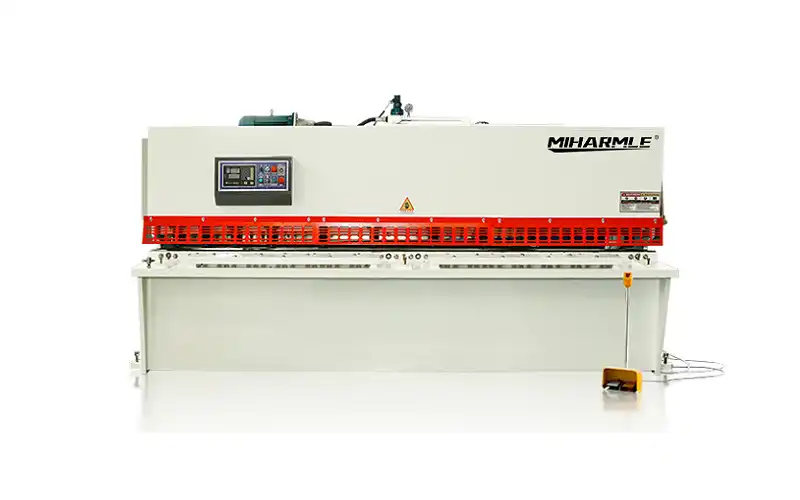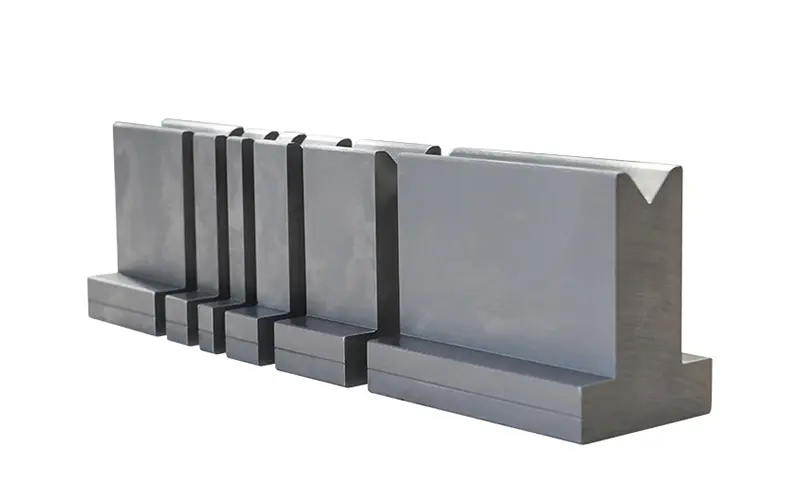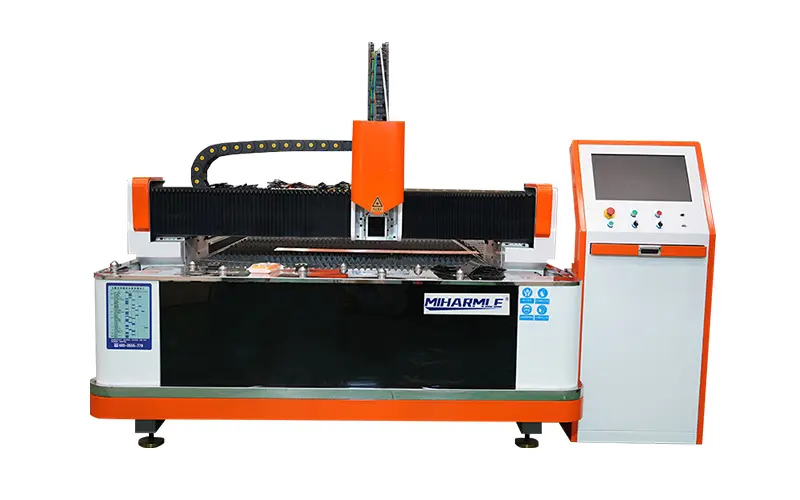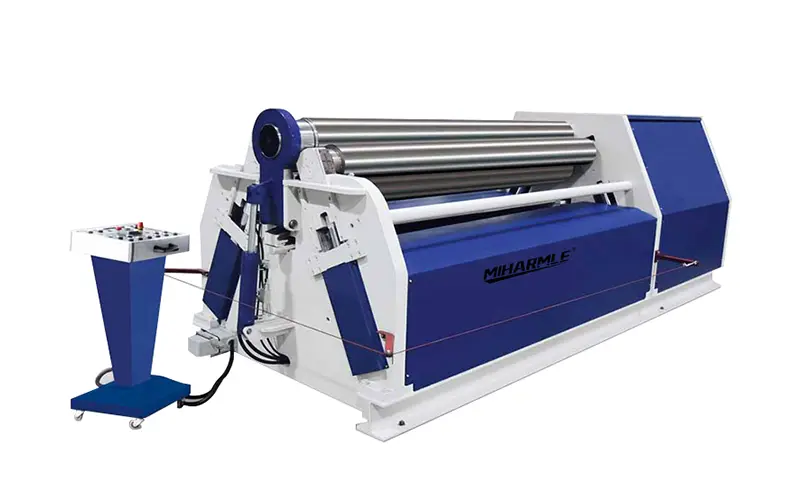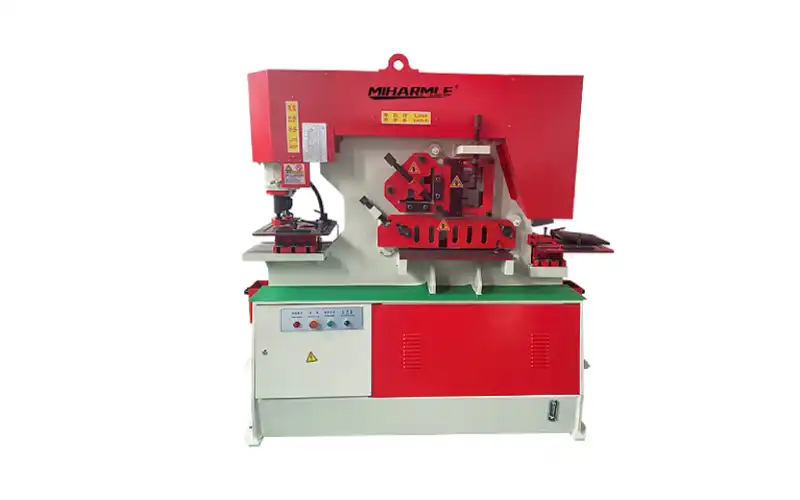
Die Entscheidung, in welche Abkantpresse man investieren soll, kann eine schwierige Aufgabe sein. Mechanische Pressen sind erschwinglich, aber nur für einfache Biegeaufgaben geeignet. CNC-Pressen sind teuer, aber schneller und zuverlässiger. Eine Investition in die falsche Abkantpresse kann zu Schäden und Verlusten führen. Geeignete Abkantpressen hingegen sind immens profitabel. In diesem Artikel geben wir Ihnen die wichtigsten Punkte zur Auswahl von Abkantpressen. Was sind einige wichtige Dinge, die beim Kauf einer Abkantpresse zu beachten sind? Was sind einige Dinge, die nicht so wichtig sind? Nach dem Lesen dieses Artikels werden Sie beides verstehen.
Was ist eine Abkantpresse?
Eine Abkantpresse ist ein industrielles Gerät, das zum Biegen von Blechen verwendet wird. Ihre Hauptbestandteile sind eine vertikale Presse und eine Matrize. Die Presse schlägt auf das Blech, das auf die Matrize gelegt wird, so dass es im gewünschten Winkel gebogen wird. Der Hauptzweck von Abkantpressen besteht darin, Bleche in einem bestimmten Winkel zu biegen oder zu krümmen. Sie werden in der Industrie, in Fabrikationsbetrieben und in Metallwerken eingesetzt.
Wie wählt man eine Abkantpresse aus?
Wenn Sie eine Abkantpresse kaufen, sollten Sie sich über einige Punkte im Klaren sein. Welche Arten von Materialien wollen Sie verarbeiten? Wollen Sie zum Beispiel leichtere Metalle wie Aluminium biegen? Mittlere Metalle wie rostfreien Stahl? Oder harte Metalle wie Kohlenstoffstahl? Wenn Sie starke Materialien biegen wollen, benötigen Sie eine Abkantpresse mit hoher Tonnage.
Ein weiterer Faktor ist die Blechdicke. Wie dick sind die Bleche, die Sie biegen müssen? Elektrische Pressen sind effizient und schnell, aber sie sind nicht für dicke Bleche geeignet.
Die Länge des Blechs bestimmt die Größe der Maschine. Um ein langes Blech zu biegen, benötigen Sie eine Maschine mit einem großen Bett. Alternativ können Sie mit Tandemmaschinen Abkantpressen kombinieren. Dadurch wird die Biegelänge erhöht.
Für hohe Produktionsraten und komplexe Biegeaufgaben sind CNC- und Roboterpressen die ideale Wahl. Sie sind hoch automatisiert und mit einer Vielzahl von Software-Tools ausgestattet.
Verständnis der Abkantpressen-Typen
In den vorangegangenen Abschnitten haben wir verschiedene Arten von Abkantpressen erwähnt. In diesem Abschnitt werden wir sie im Detail besprechen.
Hydraulische Abkantpresse
Hydraulische Abkantpressen erzeugen Kraft durch den Druck von Flüssigkeiten. Sie haben Zylinder, die unter Druck stehendes Wasser enthalten, das den Stößel antreibt und den Stempel nach unten drückt. Sie haben eine hohe Tonnage und können dicke Bleche biegen.
Hydraulische Abkantpressen haben mehrere Ölzylinder in ihrer Baugruppe. Diese ermöglichen verschiedene Biegeeinstellungen. Daher können sie einen hohen Präzisionswert erreichen. Allerdings sind die Zylinder einer hydraulischen Presse anfällig für Leckagen. Außerdem sind diese Abkantpressen energieintensiv, da sie im Ruhezustand Strom verbrauchen. Für komplexe Biegeaufgaben sind sie nicht geeignet.
Mechanische Abkantpresse
Es handelt sich um die ältesten Abkantpressen, die in ihrer Konstruktion und Anwendung einfach sind. Sie verbrauchen Strom, um ein Schwungrad anzutreiben, das die Kraft erzeugt, die der Stößel benötigt. Mechanische Abkantpressen sind einfach zu bedienen und eignen sich zum Biegen dicker Bleche.
Die mechanische Abkantpresse kann jedoch nicht anhalten, sobald das Schwungrad zu rotieren beginnt. Daher sind sie nicht für Mehrfachbiegevorgänge geeignet. Bei einigen älteren Modellen muss der Biegewinkel manuell eingestellt werden, was die Sache zusätzlich erschwert.
Elektrische Abkantpresse
Elektrische Abkantpressen arbeiten mit Strom. Sie erzeugen Strom aus Servomotoren. Diese Motoren sorgen für die Kraft, die den Stößel bewegt. Sie sind mit Computersteuerung und Software-Tools ausgestattet. Aus diesem Grund werden sie auch als CNC-Abkantpressen. Aufgrund der höheren Automatisierung eignen sie sich für mehrere Biegeaufgaben. Die Servomotoren können abgeschaltet werden, wenn sie nicht in Gebrauch sind, was elektrische Abkantpressen sehr energieeffizient macht.
Elektrische Abkantpressen bieten zwar deutliche Vorteile, sind aber in ihrer Tonnage begrenzt. Sie eignen sich nicht für das Biegen starker Materialien oder dicker Bleche. Sie sind teuer in der Einrichtung, haben aber niedrigere Betriebskosten.
Hybrid-Abkantpresse
Diese kombinieren die Stärken von elektrischen und hydraulischen Bremsen, indem sie Hydraulikzylinder mit Elektromotoren kombinieren. Dies reduziert die Abhängigkeit vom Hydrauliksystem und spart Energie. Hydraulikzylinder erzeugen mehr Kraft als Servomotoren, was zu einer höheren Tonnage führt.
Hybrid-Abkantpressen sind teuer in der Installation, und die Wartungskosten im Falle von Ausfällen sind hoch. Die Möglichkeit des automatischen Starts und Stopps ist jedoch ein großer Vorteil für komplexe Aufgaben.
Welche Art von Kurve sollten Sie wählen?
Bei der Herstellung von Metall stehen drei verschiedene Biegeverfahren zur Verfügung. Diese bieten bei bestimmten Anwendungen deutliche Vorteile. Wenn Sie diese Biegearten verstehen, können Sie die beste Entscheidung treffen.
Luftkurve
Beim Luftbiegen dringt der Stempel nicht vollständig in die Matrize ein, sondern es verbleibt eine Lufttasche im Zwischenraum. Bei der Höhe der aufgebrachten Kraft wird die Rückfederung des Materials berücksichtigt.
Durch das Luftbiegen können Sie mehrere Arten von Winkeln und Biegungen mit demselben Satz von Formen erzielen. Dies macht es zu einer kostengünstigen Biegetechnik. Die erforderlichen Abmessungen entnehmen Sie bitte der vom Hersteller bereitgestellten Tonnentabelle.
Die Art der Form wird auf der Grundlage der Eigenschaften des Blechs, wie Härte und Verformbarkeit, ausgewählt. Trotz ihrer Vorteile ist diese Methode nicht ideal für das Biegen großer Bleche.
Untere Biegung
Beim Unterbiegen wird der Radialstempel vollständig in die Matrize gedrückt. Der Stempel rastet in der Matrize ein und entfernt jeglichen Luftraum. Das Eintreiben des Stempels in die Matrize erfordert mehr Kraft als das Luftbiegen. Auch die Rückfederung des Metalls muss bei der Festlegung der Tonnage berücksichtigt werden.
Da die Matrize den Winkel der Biegung bestimmt, ist das Bodenbiegen für lange Bleche zuverlässig. Allerdings ist die beim Luftbiegen verfügbare Bandbreite an Winkeln hier nicht möglich. Außerdem erfordert es mehr Zeit und Arbeitskraft, da in jeder Konfiguration nur ein Winkel möglich ist.
Impressum Biegung
Beim Prägebiegen wird das Metallblech unter dem Stempel vollständig zusammengedrückt. Der Name leitet sich von dem Verfahren ab, mit dem Texte auf Bleche geprägt werden. Die Abkantpresse arbeitet mit maximaler Kapazität, um den Stempel in die Matrize zu drücken. Außerdem wird eine zusätzliche Kraft aufgebracht, um das Metall zu komprimieren, wodurch seine Dicke um etwa 10-15% verringert wird. Das Druckbiegen erfordert im Vergleich zu anderen Biegeverfahren den höchsten Kraftaufwand. Es ist die genaueste Biegemethode mit der höchsten Konsistenz.
Was sind die anderen Auswahlkriterien für eine Abkantpresse?
Wir haben einige der Hauptkriterien für die Auswahl von Abkantpressen erörtert. Es gibt jedoch auch einige sekundäre Überlegungen. Lassen Sie uns einige wichtige Werkzeuge besprechen, die Ihnen helfen, Ihre ideale Biegemaschine zu finden.
Back Gauge System
Moderne Abkantpressen verfügen häufig über eine Vorrichtung, die als Hinteranschlag bezeichnet wird. Er dient dazu, das Blech in die exakte Position zu bringen, in der es gebogen werden soll. Bei komplexen Biegeaufgaben mit mehreren Biegungen hilft der Hinteranschlag bei der Blechausrichtung. Er kann so programmiert werden, dass er sich mit jedem Hub bewegt und so mehrere Biegungen nacheinander erzeugt.
Winkelkontrolle
Die Winkelsteuerung in Biegemaschinen wird zur Herstellung hochpräziser Biegungen eingesetzt. Sie ist beispielsweise in industriellen Werkstätten nützlich, wo die Fehlertoleranz sehr gering ist. Die Laser-Winkelkontrolle und die optische Winkelkontrolle sind zwei beliebte Arten. Sie verringern die Arbeitsbelastung des Bedieners und helfen, Programmfehler zu vermeiden.
Form System
Das Werkzeugsystem bezieht sich auf die beiden Teile der Abkantpresse: den Stempel und die Matrize. Die Wahl des Werkzeugs hängt von der Komplexität Ihrer Biegeaufgabe ab. Je nach Art der Biegeaufgabe benötigen Sie möglicherweise unterschiedliche Formen.
Haushalt
Für jede Metallwerkstatt und jeden Verarbeiter ist das Budget ein wichtiger Faktor. Der Preis kann je nach Art der Maschine drastisch variieren. Hochautomatisierte CNC-Maschinen mit Winkelsteuerung können zwischen $3000 und $30.000 kosten. Mechanische Biegemaschinen sind dagegen billiger und besser für einfache Aufgaben geeignet. Die Investition in eine qualitativ hochwertige Abkantpresse ist jedoch sehr empfehlenswert.
Marke und Lieferant
Achten Sie beim Kauf einer Biegemaschine darauf, dass der Lieferant der Abkantpresse bekannt und zuverlässig ist. Berücksichtigen Sie Faktoren wie Wartungskosten, Servicegebühren, Garantie und Versicherung. Achten Sie nicht nur auf den Preis oder auf Anzeigen, in denen Abkantpressen zum Verkauf angeboten werden. Berücksichtigen Sie die Geschichte des Unternehmens bei der Herstellung von Abkantpressen und seinen Wert in der Branche.
Status des Betreibers
Abkantpressenbediener sind spezialisierte Techniker, die die Presse bedienen. Sie beaufsichtigen den Biegeprozess und führen verschiedene Qualitätskontrollen durch. Bei CNC-gesteuerten und automatisierten Abkantpressen müssen diese Bediener auch in Simulationssoftware geschult sein.
Die Abkantpresse, die Sie kaufen, muss über ausreichende Sicherheitsmerkmale verfügen. Barriereschutzvorrichtungen verhindern den unbefugten Zutritt, und Lichtvorhänge schalten die Maschine ab, wenn ihre Nähe verletzt wird. Nottasten ermöglichen die manuelle Überbrückung des Maschinenbetriebs. Diese Funktionen sind nicht nur für die Sicherheit des Bedieners wichtig, sondern sorgen auch für einen reibungslosen Betrieb und minimale Unfallzahlen.
